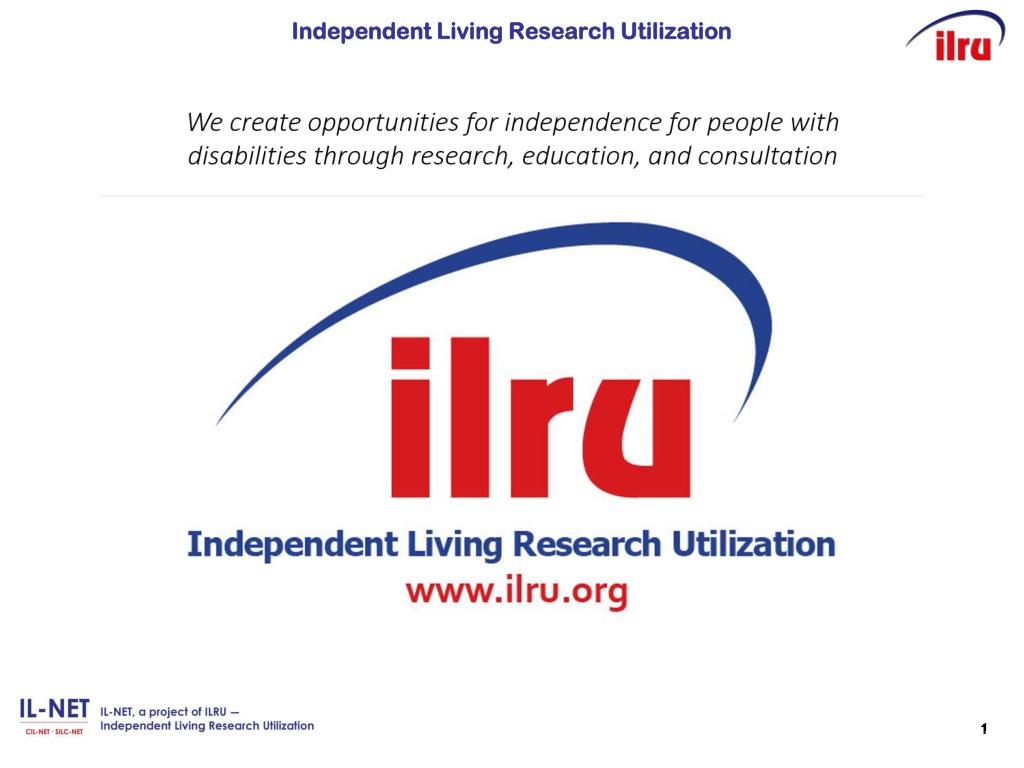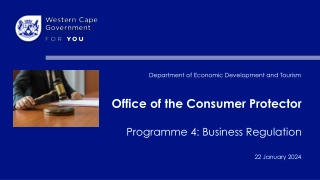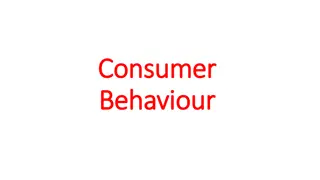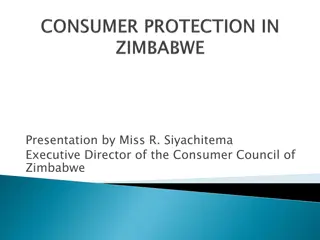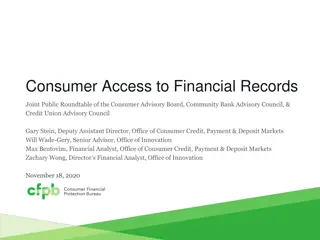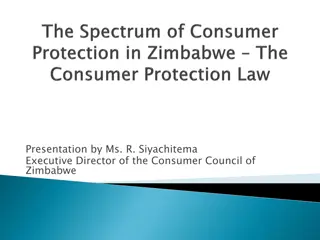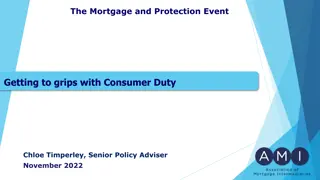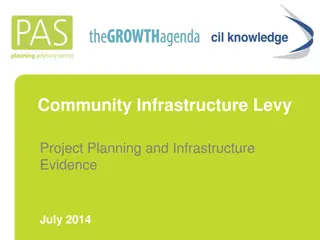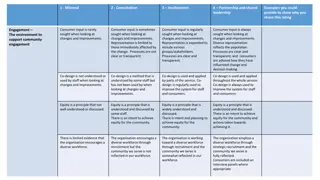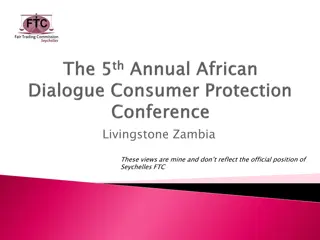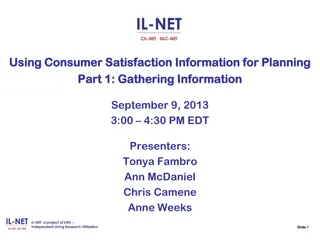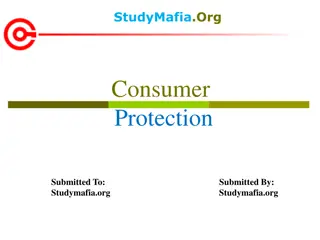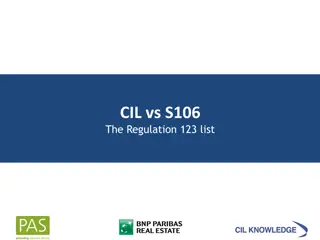Integrating CIL Core Services for a Holistic Consumer Experience
Seamlessly integrating transition & diversion into core services for independent living, including information and referral services, skills training, peer counseling, advocacy, and transition support for individuals with disabilities in various settings.
Download Presentation

Please find below an Image/Link to download the presentation.
The content on the website is provided AS IS for your information and personal use only. It may not be sold, licensed, or shared on other websites without obtaining consent from the author. Download presentation by click this link. If you encounter any issues during the download, it is possible that the publisher has removed the file from their server.
E N D
Presentation Transcript
Independent Living Research Utilization Independent Living Research Utilization 1 1
Getting to the Core of It: Getting to the Core of It: Integrating CIL Core Services for a Holistic Consumer Integrating CIL Core Services for a Holistic Consumer Experience Experience Seamlessly Integrating Transition & Diversion Into Core Seamlessly Integrating Transition & Diversion Into Core Services Services May 4, 2018 May 4, 2018 Phoenix, AZ Phoenix, AZ Presenters: Presenters: Darrel Christenson Darrel Christenson Michelle Crain Michelle Crain Bruce Darling Bruce Darling Amina Donna Kruck Amina Donna Kruck 2
Defining At Defining At- -Risk & Broad Overview of the Law Broad Overview of the Law Risk & Bruce Darling Bruce Darling 3
The Core IL Services The Core IL Services In the Law In the Law Definition: Core Services Independent living core services mean, for purposes of services that are supported under the Independent Living Services (ILS) or Center for Independent Living (CIL) Programs (A)Information and referral services; (B) Independent Living skills training; (C) Peer counseling, including cross-disability peer counseling; (D) Individual and systems advocacy; 4
Core Service: Transition Support Core Service: Transition Support (E) Services that: (i) Facilitate the transition of individuals with significant disabilities from nursing homes and other institutions to home and community-based residences, with the requisite supports and services. This process may include providing services and supports that a consumer identifies are needed to move that person from an institutional setting to community based setting, including systems advocacy required for the individual to move to a home of his or her choosing; 5
Core Service: Transition Support (2) Core Service: Transition Support (2) (ii) Provide assistance to individuals with significant disabilities who are at risk of entering institutions so that the individuals may remain in the community. A determination of who is at risk of entering an institution should include self-identification by the individual as part of the intake or goal-setting process; and (iii) Facilitate the transition of youth who are individuals with significant disabilities, who were eligible for individualized education programs under section 614(d) of the Individuals with Disabilities Education Act (20 U.S.C. 1414(d)), and who have completed their secondary education or otherwise left school ... 6
1329.5 Indicators of Minimum 1329.5 Indicators of Minimum Compliance Compliance To be eligible to receive funds under this part, a Center must comply with the standards in section 725(b) and assurances in section 725(c) of the Act, with the indicators of minimum compliance, and the requirements contained in the terms and conditions of the grant award. 7
Lets drill down in those regulations... Let s drill down in those regulations... INSTITUTIONAL TRANSITION Facilitate the transition of individuals with significant disabilities from nursing homes and other institutions to home and community-based residences, with the requisite supports and services. This process may include providing services and supports that a consumer identifies are needed to move from an institutional setting to community based setting, including systems advocacy required for the individual to move to a home of his or her choosing;.... 8
Lets drill down, contd. Let s drill down, cont d. INSTITUTIONAL DIVERSION Provide assistance to individuals with significant disabilities who are at risk of entering institutions so that the individuals may remain in the community. A determination of who is at risk of entering an institution should include self-identification by the individual as part of the intake or goal-setting process. We have been calling this diversion because it simplifies communication and is commonly understood. 9
What It Means to be At What It Means to be At- -Risk Risk What does it mean for a person to be at risk of entering an institution and how can it be avoided? Some believe that having a significant disability alone makes a person at risk of institutional placement. Some believe that consumer self-identification alone may be enough to consider a person at risk. Others believe that self-identification and having a significant disability are key components, but other factors, or a combination thereof, may present a more comprehensive picture of at-risk. 10
What It Means to be At What It Means to be At- -Risk, Risk, cont d. cont d. Common At-Risk Factors: Homelessness Chronic Medical Conditions Substance Abuse Issues with Taking Medications Living Alone Age Lack of Assistance with Activities of Daily Living No/Minimal Income No/Minimal Family Support 11
Avoiding Avoiding Unwanted Institutionalization Unwanted Institutionalization No matter the approach CILs may take in assessing risk, the ultimate goal is to divert consumers from institutional settings by utilizing the core and auxiliary services that CILs already provide. 12
Providing for Diversion and Transition Providing for Diversion and Transition through Existing Core through Existing Core Services & & Early Interventions Early Interventions Services Darrel Christenson Darrel Christenson 13
Providing Diversion & Transition Providing Diversion & Transition Through Existing Services Through Existing Services The Original Core Services Information & Referral Peer Support Independent Living Skills Training Individual Advocacy Systems Advocacy You are already providing these. Nothing is new. 14
Information & Referral Information & Referral Knowledge is Power. Learning about the Disability Community, Resources, Services and Programs is vital to both populations. CIL services internally assist in BOTH keeping consumers in the community AND moving consumers back into the community. Referrals to community partners/ resources also achieve BOTH objectives. CILs need to be knowledgeable to assist consumers. 15
Peer Counseling/Support Peer Counseling/Support Who better to assist consumers than peers?! CILs are represented by a majority of persons with disabilities a built-in base. Both populations learn from individuals who have been there, done that. Shared experiences and stories are powerful ways to learn and grow confidence. Volunteer Peer Mentors are useful extensions of staff recruit and train them to assist. 16
Independent Living Skills (ILS) Training Independent Living Skills (ILS) Training IL skills include: financial management, cooking, goal setting, transportation, sexuality, social skills, etc. Teaching IL skills reduces the reliance on others. (parents, attendants and other paid professionals, etc.) Increases skills and abilities for one s self. Increases confidence and self-esteem. Increases safety and independence. 17
Individual Advocacy Individual Advocacy Assists both populations by speaking up for one s needs and desires (stay out of or move out of an institution). Learning how to advocate and know that your needs are valid. CILs teach self advocacy skills AND advocate WITH (not for) the consumer. Expressing empowerment and confidence. 18
Systems Advocacy Systems Advocacy Making communities more accessible and inclusive so individuals can make use of the information, resources, and skills they acquire through IL services. 19
Early Intervention Program at Early Intervention Program at Ability360 Ability360 The Early Intervention program began as a response to an identified community need nearly 17 years ago. 20
Early Intervention Program at Early Intervention Program at Ability360, Ability360, cont d. cont d. The program provides outreach to individuals in the rehabilitation hospitals who have a newly acquired disability. Sixty (60%) percent of the unduplicated individuals with newly acquired disabilities, contacted in the program, have had a spinal cord injury (SCI) and/or traumatic brain injury (TBI). Visits to rehabilitation facilities are regularly scheduled to meet with individuals and their families shortly after a catastrophic trauma resulting in a profound disability. 21
Service Area and Demographics Service Area and Demographics Service Area: The program is integrated with the services at medical rehabilitation facilities throughout Maricopa County/ Phoenix metropolitan area. Demographics: 70% males / 30% females 49% between ages 31-54 71% white, 15% Hispanic, 8% Native-American = representative of the population 75% earning less than $10,000 (injured, not working) Valley-Wide 22
T The Problem Being he Problem Being A Addressed A stroke, an automobile accident, a drive-by shooting, whatever the cause, acquiring a disability means losing the use of a significant part of one s physical, sensory, or cognitive ability. It can happen quickly, and it impacts individuals, marriages, families, and the community. No one is ever expecting a disability or is prepared to deal with it. ddressed 23
T The Problem Being Addressed, he Problem Being Addressed, cont d. cont d. Medical professionals do a great job at putting bodies back together. However, the things needed for the psychosocial adjustment to disability are not necessarily available through medical professionals or insurance companies. 24
According to the National Council on According to the National Council on Disability Disability The unemployment rate for persons with disabilities is nearly 70% The suicide rate for persons with a spinal cord injury is significantly higher than for persons without a disability. The result many individuals with newly acquired disabilities often feel unable to cope, become isolated, go through bouts of depression, struggle to readjust, experience family turmoil and separation, and often accept a life on public assistance. 25
Early Intervention Programs Early Intervention Program s Purpose, Measurable Goals, and Purpose, Measurable Goals, and Objectives Objectives Ability360 s program. . . Introduces individuals to the Independent Living Philosophy of self-determination, Provides peer support, and Presents an overview of strategies, resources, and services needed for living with a disability. 26
Early Intervention Programs Purpose, Early Intervention Program s Purpose, Measurable Goals, and Objectives, Measurable Goals, and Objectives, cont d. cont d. Ability360 s program. . . Provides information and peer support that increases the likelihood that consumers will adapt to their disability and be diverted from institutional setting back into the community. Shows through self reporting that education of resources gives knowledge and self-empowerment. Integrates all of our services and addresses the whole person, avoiding institutionalization. 27
Program Objectives Program Objectives OBJECTIVE 1: In collaboration with local rehabilitation facilities & extended care centers conduct outreach meetings/site visits. OBJECTIVE 2: Introduce Independent Living Philosophy to newly disabled individuals. OBJECTIVE 3: Facilitate peer mentor matches. OBJECTIVE 4: Assist Ability360 Volunteer Coordinator to recruit, train, and oversee new peer mentors. 28
Program Objectives, Program Objectives, cont d. cont d. OBJECTIVE 5: Conduct follow-up surveys post discharge to assess and evaluate adaptation and community integration, and re-intervene where appropriate. OBJECTIVE 6: Distribute copies of Ability360 s Disability Survival Guide. OBJECTIVE 7: Participate in civic commission, committee, council, or other related community-oriented organization meetings that focus on disability issues. 29
Building the Program Building the Program Establish relationship with rehab centers, case managers, occupational and physical therapists, and rehab directors. Offer to do "in services" to educate their staff on ILC services. If you have local colleges offering degrees related to rehabilitation, offer to instruct a class. Have a presence at conferences, summits, health fairs, etc. Be as visible as possible. If possible, have your brochures available to the patients in the rehab. 30
Tools Tools The program coordinator is the first tool: a person with a disability has instant credibility. The CIL's programs are the next important tool, especially peer mentors, IL skills, and I&R. Other tools include: program brochures, newsletters, and disability survival guides. Consumers are bombarded with information. We give them a folder to keep brochures organized. 31
Interactions Interactions Referrals can be made by family members, rehab staff, case managers, or the consumer themselves. Never make a visit without the consumer s knowledge and consent. Most visits are made in the afternoon, post-therapies. Often it is a family member or members who have the most questions. It is important for the Coordinator to stay on top of resources and be knowledgeable about services 32
Interactions, Interactions, cont d. cont d. When possible, collect contact information from the consumer for follow up in the future. It s important to understand and recognize the stages of grieving. Patients are often tired, medicated, and emotionally drained. Be sensitive to their fatigue (aware of non- verbal cues.) 33
Measuring Outcomes Measuring Outcomes Knowledge of consumers to be involved in their rehab planning and therapy programs. Encouragement to be actively involved in focusing on their futures. Tracking individuals returning to a residential setting. Observing proactive self-advocacy skills. 34
Methods to Methods to Gather Measurable Measurable R Results Regularly scheduled visits to rehab units to meet with rehab staff for referrals to newly individuals with newly acquired disabilities and their families. One-to-one meetings with newly disabled individuals and their families; often weekly visits while they are in rehab. Gather and esults and Collate Collate 35
Methods to Gather and Collate Methods to Gather and Collate Measurable Results Measurable Results, , cont d. Regularly scheduled discussions with rehab staff to review and assess intervention, and to identify specific issues that need to be addressed. The staffs at rehab units view our activity as an important adjunct. Facilitating focused discussions on particular aspects of Independent Living Philosophy in support group meetings. Conducting follow-up surveys at regular intervals. cont d. 36
The P The Program Uses rogram Uses a a Three C Collaborative ollaborative P Partner Three- -Pronged Pronged artner A Approach pproach 1. The program is completely integrated with Ability360 s other independent living programs. 2. The program collaborates with medical rehabilitation facilities. These relationships are mutually beneficial as staff refer individuals to Ability360. 3. The program collaborates with other disability- related and community organizations. Diversion from institutions to the community is always the bottom line goal. 37
Case Example Case Example Steve met Coordinator in rehab after he experienced a stroke. Shared community resources and information Steve started mentoring others in rehab He became involved in our services such as: Living Well with a Disability Peer Mentoring Men s Support Group Sports & Fitness Center IL Classes Steve is currently pursuing a small business of creating an accessible kitchen with cooking classes for persons with disabilities. Steve Steve 38
Things to Consider Things to Consider Funding Early years the program was funded by Valley of the Sun United Way. Currently, program revenue comes from discretionary and unrestricted dollars from the Home Care Program. Staffing needed. Existence of rehab facilities in your service area. Rehab reluctance (confidentiality/HIPPA/liability issues). 39
Most Most Common Common C Concerns Consumers Consumers Housing Quality of life Sexuality/ Relationships Daily Functionality Questions oncerns of of 40
Most Common Concerns of Most Common Concerns of Consumers, Consumers, cont d. cont d. The Coordinator should be positive and living proof that there is life after disability. However, it is important to be honest and realistic no cheerleader mode. People are comforted in knowing they are not alone, that there is a community out there available to support them. Technology helps reduce, but not eliminate, the isolation of rural populations. 41
Bottom L Bottom Line ine We want to give consumers and their families tools they can use after rehab to avoid becoming depressed, lost and isolated. Prevent the downward spiral of depression, drug-use, and isolation. 42
Embrace Diversion / Transition! Embrace Diversion / Transition! If you have concerns about your CIL providing Diversion or Transition As you see, even without additional funding, you are already doing it through the original Core Services. Consider the role of Ancillary Programs such as: Home Care Services, rehabilitation visits, Employment & Benefits to Work, Empowering Youth, Socialization through recreation, home modifications, ADA technical assistance, Many of you have these and others to assist in achieving these goals and objectives. 43
Assessing Risk for Institutionalization Assessing Risk for Institutionalization Michelle Crain Michelle Crain 44
LIFEs At LIFE s At- -Risk Assessment Tool Risk Assessment Tool Prior to the Workforce Innovation and Opportunity Act s (WIOA) requirement that Centers for Independent Living (CILs) identify individuals who are at risk of institutional placement, LIFE Inc. was already convinced that the IL services we provide keep or divert consumers from institutional settings. WIOA s mandate was the impetus for LIFE to develop its At-Risk Survey. 45
Developing LIFEs Developing LIFE s At Tool Tool In developing the survey, we looked at several research studies that addressed the nursing home placement of older adults. Staff tested the At-Risk Survey prior to its implementation in September 2015 and it has become a part of our intake and assessment process. The purpose of LIFE s At-Risk Survey is to implement a standardized approach in identifying consumers who are at-risk of institutionalization and to assist them in developing an Independent Living Plan (ILP) that will stabilize and enhance their living situation. At- -Risk Assessment Risk Assessment 46
LIFEs At LIFE s At- -Risk Assessment Risk Assessment Survey Survey The survey consists of two components: 1. Summary of 16 at-risk factors and tabulated score 2. Scoring detail that captures the individual score assigned to each at-risk factor A score of 50 and above identifies the consumer as at-risk. At-Risk Assessment: 1. Does the consumer feel that he or she is at risk of institutionalization? 2. Has the consumer been institutionalized in a long- term care facility within the last 12 months? 47
LIFEs At LIFE s At- -Risk Assessment Risk Assessment Survey, Survey, cont d. cont d. 3. Is the consumer homeless? 4. Was the Consumer referred to the center by Adult Protective Services, a physician, rehabilitation staff, etc., to avoid imminent placement into an institutional setting? 5. Has the consumer disclosed any current incidence(s) of abuse by a caregiver and/or someone in the home? 6. Has the consumer been diagnosed with specific health conditions? 48
LIFEs At LIFE s At- -Risk Assessment Risk Assessment Survey, cont d. 2 cont d. 2 7. Has the consumer been hospitalized for any of those health conditions within the last 12 months? 8. Has the consumer made 6 or more visits to the emergency room within the last 12 months? 9. Does the consumer need assistance with 3 or more activities of daily living and does not currently have a care provider? 10.Is the consumer 65 years of age or older? 11.Does the consumer have difficulty taking medications as prescribed? Survey, 49
LIFEs At LIFE s At- -Risk Assessment Risk Assessment Survey, cont d. 3 cont d. 3 12.Does the consumer live alone? 13.Is the consumer s current housing situation suitable? 14.Is the consumer s income sufficient enough to cover basic living expenses such as rent, utilities, and food? 15.Does the consumer have a history of drug or alcohol abuse? 16.Does the consumer have informal supports? Survey, Training with LIFE Staff has been ongoing, along with discussions on how to improve the survey s efficacy. 50
